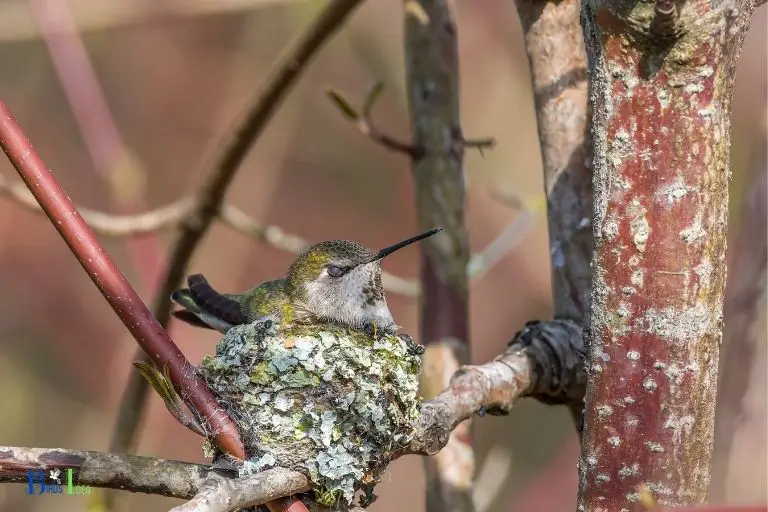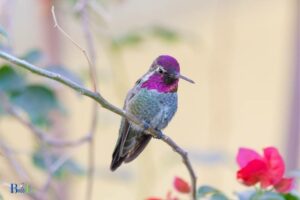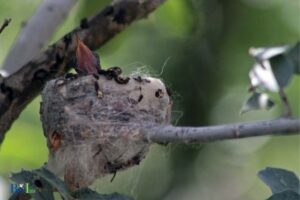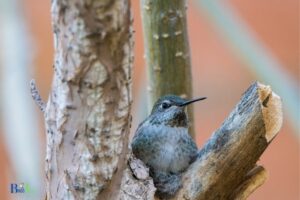How to Preserve a Hummingbird Nest? 10 Steps!
To preserve a hummingbird nest, carefully remove it from its location, clean it gently, stabilize its structure, and store it in a safe and secure environment.
Hummingbird nests are delicate and intricate structures that can be fascinating to observe and study. Preserving a nest can be a great way to appreciate these tiny birds’ incredible craftsmanship and add a unique item to your collection.
The process of preserving a hummingbird nest involves several steps to ensure it remains intact and protected.
First, when removing the nest from its location, make sure not to damage it or the surrounding branches.
Use a pair of scissors or pruning shears to carefully snip the branch it’s attached to, leaving enough length for handling. Next, clean the nest gently using a soft brush or cotton swab to remove any dirt or debris.
To stabilize the structure, apply a thin layer of white glue or clear nail polish on the inner and outer surfaces, ensuring the nest retains its shape.
Finally, store the preserved nest in a safe and secure environment like a shadow box or display case, away from direct sunlight, moisture, and pests to maintain its condition for years to come.
Step-by-Step Guide to Preserve a Hummingbird Nest
| Step | Description |
|---|---|
| 1 | Locate the hummingbird nest without disturbing the surroundings. |
| 2 | Observe the nest from a safe distance to ensure there are no eggs or chicks inside. If there are, wait until they have left the nest. |
| 3 | Carefully remove the nest from its location, taking care not to damage its structure or any attached organic materials. |
| 4 | Place the nest in a small, protective container (e.g. a plastic box with a lid) and secure it with tissue paper or soft materials to avoid movement. |
| 5 | Store the container in a cool, dry, and dark place to prevent damage from sunlight, humidity, and temperature fluctuations. |
| 6 | Consider using a desiccant packet or silica gel to maintain the appropriate humidity level inside the container, helping to preserve the nest over time. |
| 7 | Periodically check the nest for any signs of damage or mold, and address these issues promptly if they arise. |
| 8 | Handle the nest sparingly and gently, using gloves or tweezers to minimize contact with natural oils and contaminants from your hands. |
| 9 | If desired, consult with a professional conservator or naturalist for additional preservation tips and guidance. |
| 10 | Keep a record of the nest’s origin, species, and any relevant observations, to better understand and appreciate its significance in the future. |
Key Takeaway

Five Facts About Preserving Hummingbird Nests
Understanding Hummingbird Nests
What Are Hummingbird Nests?
Hummingbird nests are tiny and delicate structures created by these tiny birds to serve as their means of shelter and protection. They are usually made of lichens, moss, spider webs, ferns, leaves, and other natural materials.
Some key points about hummingbird nests are:
- They are extremely small, measuring approximately 1.5 inches in diameter.
- The nest’s weight is only a few grams since they are made up of lightweight materials.
- Hummingbirds build their nests with great care and thoughtfulness, putting them in concealed areas to protect them from predators.
- Each nest is a unique creation, tailor-made by the hummingbird to meet its specific needs.
What Do Hummingbird Nests Look Like?
Hummingbird nests differ from other bird species in numerous ways. They are small, cup-shaped nests, typically made from plant fibers and spider silk.
They usually blend into their environment, so they are not easily visible to humans or predators.
Some features of hummingbird nests include:
- Their small size and delicate appearance.
- Their cup-shaped structure, which is crafted with great care and attention to detail.
- The nests can be a broad spectrum of colors, primarily depending on the materials used to make them.
- Hummingbird nests are solid and sturdy enough to withstand harsh weather conditions.
Where Do Hummingbirds Build Their Nests?
Hummingbirds build their nests in a wide range of locations, depending on the species, terrain, and environmental conditions.
Some hummingbirds create their nests at the base of leaves, at the forks of tree branches, or other concealed areas protected from potential predators.
Here are some additional facts about where hummingbirds build their nests:
- They tend to construct their nests in sheltered locations with leaves and other vegetation to provide concealment.
- They typically build their nests in areas that are relatively close to food sources and water.
- Hummingbird nests may be constructed at various heights, from low bushes to high tree branches, depending on the hummingbird’s species and the availability of shelter.
Why Is It Important To Preserve A Hummingbird Nest?
It is essential to protect hummingbird nests because they play a significant role in the preservation of these small and delicate birds.
By safeguarding their nests, we are helping to ensure the longevity and conservation of their species.
Here are some reasons why it is important to preserve hummingbird nests:
- Hummingbirds rely on their nests to raise their young. If their nests are damaged or destroyed, they may not be able to reproduce or care for their offspring.
- Hummingbird nests are incredibly fragile and are often built in hard-to-see locations. As such, it is crucial to avoid disturbing them or attempting to move them.
- Hummingbirds are critical pollinators, helping to maintain ecosystems and promote biodiversity. By preserving their nests, we are helping to ensure an abundance of healthy plants and flowers for future generations to enjoy.
Before You Preserve A Hummingbird Nest
Preserving a hummingbird nest can be a challenging yet rewarding experience. It requires a special set of tools and materials, as well as proper preparation and safety precautions before handling the delicate nest.
Here’s what you need to know before you start preserving a hummingbird nest.
What Tools And Materials Do You Need?
To preserve a hummingbird nest, you will need the following tools and materials:
- Small paintbrush
- Fine mesh strainer
- Scissors
- Tweezers
- Dental floss
- Gloves
- Small container
- Suitable preservative solution (such as 70% ethanol or 37% formaldehyde)
How To Prepare Yourself Before Handling A Hummingbird Nest?
Before handling a hummingbird nest, it’s important to prepare yourself in order to avoid damaging the nest or harming the delicate hummingbird eggs or chicks.
Here are a few key steps you can take to prepare yourself:
- Wear gloves to avoid transferring oils or other substances onto the nest or eggs.
- Make sure to handle the nest with extreme care as it is fragile and delicate.
- Familiarize yourself with the characteristics of hummingbirds and their nests to gain an understanding of how to handle the nest.
- Choose a clean, quiet, and comfortable workspace for preserving the nest.
- Keep all tools and materials organized and ready to use to avoid damaging the nest.
Safety Precautions To Take Before Handling A Hummingbird Nest
It’s important to take proper safety precautions before handling a hummingbird nest to avoid potential hazards or harm to yourself or the birds.
Here are a few safety precautions to take:
- Wear gloves to protect yourself from any preservatives you may use.
- Avoid inhaling preservatives or other harmful chemicals.
- Keep preservatives and other hazardous materials stored safely out of reach from children and pets.
- Make sure your work area is clean and well-ventilated to avoid any accidental exposure to preservatives.
- Respect hummingbird nests and eggs and follow all legal requirements when handling them.
By adhering to these key guidelines, you can safely and effectively preserve a hummingbird nest. Remember to handle all hummingbird nests and eggs with extreme care and respect to ensure the survival of these amazing birds!
Steps To Preserve A Hummingbird Nest
Preserving A Hummingbird Nest – Steps To Follow
Hummingbirds are fascinating creatures that deserve our respect and protection. Preserving the nest of a hummingbird is not only a great way to observe and learn about these amazing birds, but also an important action towards conservation.
Here are the steps you need to follow to preserve a hummingbird nest.
When Is The Best Time To Preserve A Hummingbird Nest?
The best time to preserve a hummingbird nest is when it is no longer in use. Hummingbirds build their nests in trees, shrubs, and other structures, and they are very territorial about them.
Disturbing an active nest can cause stress to the birds and even lead them to abandon it. Therefore, it is recommended to wait until the breeding season is over, and the nest is empty before attempting to preserve it.
How To Detach A Hummingbird Nest?
Detaching a hummingbird nest requires patience and care, as they are delicate structures that can easily break if mishandled.
Here is how to do it:
- Wait until the nest is no longer in use, and the baby hummingbirds have fledged.
- Put on gloves and gently detach the nest from the tree or shrub using a pair of scissors or a knife.
- Place the nest in a small container, preferably made of soft material such as a cloth or tissue paper, to protect it from damage.
How To Safely Transfer A Hummingbird Nest?
Transferring a hummingbird nest requires attention to detail and awareness of the nest’s fragility.
Follow these steps to transfer it safely:
- Choose a suitable location to transfer the nest, preferably a well-ventilated area that is not exposed to direct sunlight or extreme weather conditions.
- Handle the nest carefully, making sure not to twist, squeeze, or move it abruptly.
- Ensure that the nest is securely placed in the container.
- Transport the nest to its new location with care, avoiding any sudden movements or bumpy surfaces that could damage it.
How To Store A Hummingbird Nest Properly?
Storing a hummingbird nest requires a dry and cool space, free from pests and dust.
Follow these steps to store it properly:
- Choose an appropriate container to store the nest, like a small cardboard box.
- Fill the container with soft material such as tissue papers to cushion the nest.
- Label the container with the date and location the nest was originally found.
- Store the container in a dry and cool space, away from direct sunlight, moisture, and pests.
How To Clean A Hummingbird Nest?
Cleaning a hummingbird nest is not recommended since it can cause damage to the fragile structure, and it can also remove any natural oils and microbes that may benefit the birds.
However, if the nest is soiled or has become infested with mites, follow these steps:
- Put on gloves and a face mask before handling the nest.
- Use a soft brush or cloth to gently remove any debris or mites from the nest.
- Avoid using any chemicals or detergents as they may harm the nest and the birds.
- Only clean the nest if it is absolutely necessary and avoid unnecessary disturbances.
Preserving a hummingbird nest is an excellent way to appreciate and understand the natural world around us.
By carefully following these steps, you can ensure the safety and protection of both the nest and the hummingbirds that rely on them.
Tips For Successful Hummingbird Nest Preservation
Hummingbirds are dainty creatures that require a lot of care. Nest preservation is important to ensure the safety of these little birds.
Below are some tips on how to preserve hummingbird nests successfully.
Common Mistakes To Avoid When Preserving A Hummingbird Nest
It is essential to avoid some common mistakes when you are preserving a hummingbird nest.
Below are some tips to avoid making common errors:
- Don’t touch or move the nest more than necessary.
- Avoid taking pictures with a flash as it scares the birds.
- Don’t use harsh chemical products to clean the nest.
How To Ensure Successful Hummingbird Nest Preservation?
Hummingbird nest preservation is crucial to ensure hummingbirds’ safety and wellness.
Here are some tips for successful hummingbird nest preservation:
- Keep the nest clean by removing any debris and fecal matter that accumulates around the nest.
- Place the nest in a spot with adequate shade and protection from strong winds.
- Keep the area around the nest free from predators, like cats, squirrels, and other animals.
- Refrain from disturbing the nest except during the routine cleaning procedures.
Tips For Maintaining Hummingbird Nest Preservation In The Long-Run
Hummingbird nest preservation is necessary for the long-run.
Here are some tips for maintaining hummingbird nest preservation in the long-run:
- Place the nest in a location that allows easy access for cleaning but is out of reach for animals and children.
- Monitor the nest regularly to ensure that the birds are thriving.
- Keep a lookout for signs of predators and take appropriate measures to protect the nest.
- Add a small amount of nesting material to the nest each season to ensure that it does not become too compact.
Following these tips for successful hummingbird nest preservation ensures that hummingbirds are comfortable and have a safe and secure space to thrive.
FAQ About Preserving Hummingbird Nests
How Do You Preserve A Hummingbird Nest?
What Should You Do If You Find A Fallen Hummingbird Nest?
Why Is It Important To Preserve A Hummingbird Nest?
What Materials Can Be Used To Preserve A Hummingbird Nest?
How Long Does It Take For A Hummingbird To Build A Nest?
Conclusion
After reading this guide, you now have a better understanding of how to preserve a hummingbird nest. Remember to approach the nest with caution and avoid disturbing it unnecessarily.
The key is to focus on maintaining the natural environment around the nest while ensuring that the birds are safe and comfortable.
By following these tips, you can help increase the chances of these beautiful creatures to continue breeding and thriving. It is always an incredible experience to witness these tiny birds building their homes and raising their young.
As stewards of the natural world, it is our responsibility to do what we can to protect these creatures and appreciate the incredible beauty they add to our world. So, go on and put these tips into practice, and happy hummingbird watching!






